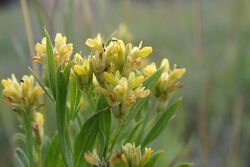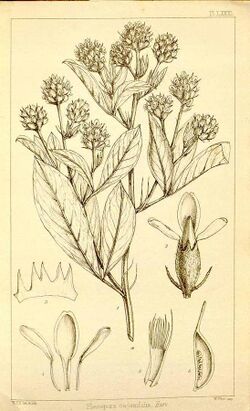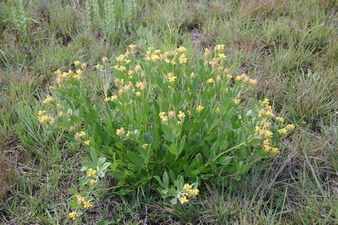Biology:Pearsonia cajanifolia
From HandWiki
Short description: Species of legume
| Pearsonia cajanifolia | |
|---|---|

| |

| |
| Plate from William Henry Harvey's "Thesaurus capensis" (1859) | |
| Scientific classification | |
| Kingdom: | Plantae |
| Clade: | Tracheophytes |
| Clade: | Angiosperms |
| Clade: | Eudicots |
| Clade: | Rosids |
| Order: | Fabales |
| Family: | Fabaceae |
| Subfamily: | Faboideae |
| Genus: | Pearsonia |
| Species: | P. cajanifolia
|
| Binomial name | |
| Pearsonia cajanifolia (Harv.) Polhill
| |
| Synonyms | |
| |
Pearsonia cajanifolia is a South African shrublet belonging to the family of Fabaceae, and one of 13 species in the genus, usually herbs or shrublets with woody rootstocks and all occurring in Africa south of the equator with the exception of 1 species found on Madagascar .[1] P. cajanifolia is commonly found in submontane grassland, at altitudes 1350–2100 m, in the South African provinces of Free State, Gauteng, Limpopo, Mpumalanga, and North West, also in Zimbabwe and Malawi.[2][3][4]
Description
Stems erect, well branched, (0.2)0.4–0.7(1.5) m tall, several from a deep taproot, pubescent to tomentose. Leaves mostly 3-foliolate, but upper ones 1-foliolate and intergrading to bracts; leaflets 3–6.5(9) × 0.8–2.5(3) cm, oblanceolate to elliptic or obovate, apiculate, thinly pubescent to silvery sericeous-tomentose; lower lateral nerves steeply ascending, reticulation rather prominent; petiole 0.5–2.8 cm long; stipules 0.4–1(1.4) cm long, linear-subulate. Flowers yellow, (3)8–30(40) in heads or short dense racemes often aggregated into panicles by suppression of upper leaves; bracts subtending flowers 4–8 mm long, linear or linear-lanceolate; bracteoles on the very short pedicels a little smaller. Calyx 6–10 mm long, tomentose; upper lip c. 1–1.5 times as long as the tube, with the lateral sinuses as high as or higher than the upper sinus; upper lobes 2–4 mm long, narrowly to broadly triangular-acuminate. Standard 8–13 × 3–7 mm, usually elliptic-oblong, pubescent outside. Stamens all joined. Ovary 6–12-ovulate. Pod little exserted from the calyx, 6–8 × 3–4 mm, oblong-ellipsoid, pubescent, usually only 2-seeded. Seeds c. 1 mm long, oblique-cordiform.—Flora Zambesiaca volume:3 part:7
Gallery
References
- ↑ "Search results — the Plant List". http://www.theplantlist.org/tpl1.1/search?q=Pearsonia.
- ↑ "Threatened Species Programme | SANBI Red List of South African Plants". http://redlist.sanbi.org/species.php?species=276-4.
- ↑ "Flora of Zimbabwe: Species information: Pearsonia cajanifolia subsp. Cryptantha". http://www.zimbabweflora.co.zw/speciesdata/species.php?species_id=127420.
- ↑ "CJB - African plant database - Detail". http://www.ville-ge.ch/musinfo/bd/cjb/africa/details.php?langue=an&id=62266.
- ↑ "Plants of the World Online | Kew Science". http://apps.kew.org/efloras/namedetail.do?flora=fz&taxon=2862&nameid=6989.
Wikidata ☰ Q15539671 entry
 |


